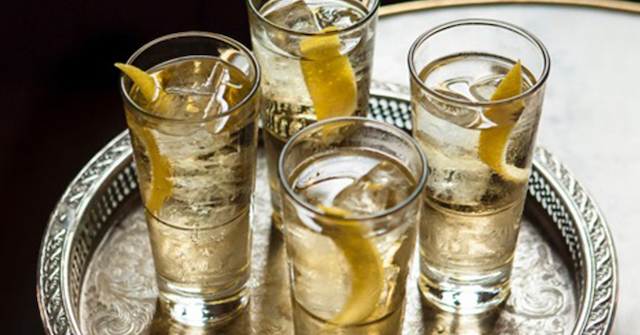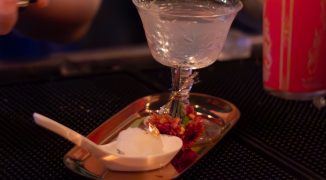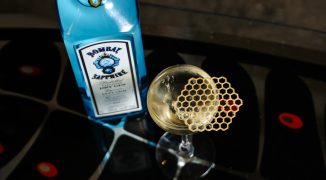L’apéritif. Or, l’apéro, for short, as in, On prend l’apéro, or let’s get/have a drink.
But while the phrase and the timing after work suggests the American happy hour, the French aperitif is so very different and so much more. “The happy hour is to celebrate the end of the day. You’ve been busy at work, you go to a bar and get drinks, then go home and call it a day,” says Camille Vidal, global ambassador for St-Germain. “The aperitif is something else. It’s not at the end of something, it’s the beginning of something.”
Aperitif, Vidal explains, comes from the Latin verb, aperire, which means to open. “An aperitif is meant to open your stomach, to get ready for dinner, and it also means it is the opening of the night,” Vidal says. “Having this understanding that an aperitif is the opening of something means that it holds a very different set of mind, and to me, that’s the big difference between happy hour and aperitif culture.”
In French culture, the aperitif is a centuries-old tradition that has its roots in the Middle Ages. “It’s a civilized way to wind down and to get your appetite ready for digesting your food,” says Daniel Cooney, who owns Heavenly Spirits import company with his French-born wife, Christine, and imports several aperitif-friendly liqueurs. “It’s a perfect way to wind down from the day’s activities and to prepare yourself for a night of relaxation, dining and civilized living.”
While getting an aperitif includes both food and drink, the underlying purpose is to connect with friends and family. “It’s not just to open the appetite, it’s more something to get social and to get together and to spend some good time, to have a nice drink with family and friends,” says Kevin Charuel, brand ambassador for Marie Brizard. “It’s more sharing some precious time.”
An aperitif might be a glass of wine or beer, but it often is a liqueur or a cocktail. But if it’s a cocktail, it’s not going to be heavy on the booze. “It should be something light and refreshing, with a low ABV,” Vidal says.
In France, traditionally, that could mean a kir, which is white wine and crème de cassis or a kir royale, which uses sparkling wine, using a ratio of one ounce of liqueur to four ounces of wine, Charuel notes. In the south of France, where Vidal is from, they serve a drink called mauresque, which combines pastis with orgeat.
“We don’t usually use champagne for a kir royale, instead we use a cremant,” Charuel says.
Whether it’s a kir or an ale, it’s most definitely going to be served with a bit of food. “We always pair our aperitif with some snacks or finger foods,” Charuel says.
“Traditionally, you have your aperitif with some snacks so your appetite gets working,” Cooney says. “Then you introduce your wine with dinner.”
While the French often carefully pair wines with food courses, the aperitif doesn’t require that attention to detail. It’s usually just some cheeses or charcuterie, maybe a little bit of bread and nuts or chips. “You drink what you want to drink, and you eat what you want to eat for an aperitif,” Charuel says.
But it’s not a large portion. “It’s setting yourself up for a better dining and living experience,” Cooney says.
It’s also an experience that bars and restaurants in the United States and other countries are recognizing as something of interest to their clientele. Some bars have whole cocktail sections devoted to aperitif drinks and liqueurs. “After a long day at work, you don’t want something too strong. You want something to ease into the night,” says Vidal, who believes so strongly in different drinks for different times of the day that she’s written a new book on the subject, “How to Drink French Fluently.” “It’s common sense. You don’t eat the same thing at different times of the day. I would love to see people look at cocktails the same way and see more cocktail menus reflect this.”
Vidal says these drinks, like traditional French aperitif cocktails, have that low ABV, but that doesn’t mean that they are one-note cocktails without layers of flavor. “You can still have a cocktail that has a lot of aromatics and flavor without becoming too much,” Vidal says.
“The interesting thing about low ABV cocktails is they are inexpensive to make, and customers can order more of them,” Charuel notes.
A lot of the traditional French spirits that have been served as aperitifs naturally contain a lot of herbs, aromatics and spices. Some are very well known, like the anise-scented pastis and the gentian-root accented Suze, but others like La Troussépinète get their aromas from blackthorn shoots.
Bars and restaurants that offer aperitif sections often see customers come in in the afternoon or early evening, and the aperitif leads to dinner, which leads to after dinner drinks and much lingering. “If people are having a great time, they stay longer,” Vidal says.
And adding an aperitif section doesn’t mean that it has to be strictly French. “Many cocktails can be aperitif drinks,” Charuel says.
“It’s almost a celebration that we do,” Vidal explains. “But it’s a celebration that’s part of our everyday life, not something to celebrate in particular.”




